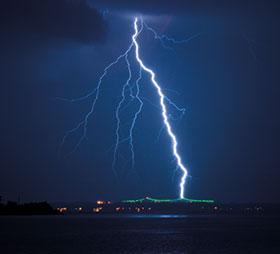

Why do we need protection?
Lightning strikes
Lightning activity occurs worldwide, in some areas minimal, in others moderate, and in some places extreme. Wherever there is lightning activity, huge amounts of energy may be induced into electrical reticulation, in many instances causing catastrophic damage. To protect systems against this phenomenon, lightning protection is required. It is also important to know that lightning protection should always be used in conjunction with surge protection as described below.
Other surges
Surge (other) protection is another matter. In general, surges are manmade and mostly generated by electrical switching operations. Examples of these could be the starting of inductive loads, or power failures.
Obviously, these transients can affect electrical supplies 24/7. Therefore, surge (other) protection is an imperative – even if you are not situated in a lightning area, surge (other) protection is still necessary.
These extremely fast voltage and current disturbances, including lightning, which I prefer to call transients, cause hundreds of millions of Rands worth of damage to equipment every year.
What do we use for protection?
Protection is broken up into three categories, namely:
• Type 1 (Class I) – Coarse protection. These devices are used for protection against lightning transients. Normally situated in the primary mains supply DB distribution board and used in conjunction with Type 2 devices.
• Type 2 (Class II) – Medium protection. These devices are used for protection against other surges i.e. switching transients. Normally situated in the secondary DBs and supplied from a main DB, which would contain Type 1 devices. Should there be only one DB servicing a facility with no secondary DBs, a combination of Type 1 and 2 device should be installed in the DB.
• Type 3 (Class III) – Fine protection. These devices are used for protection against low energy surges, which can damage sensitive equipment. These devices are normally situated as close as possible to the equipment to be protected. Type 3 devices may be used in all areas of electrical/electronic applications including: mains power supply (AC and DC), MCR (measurement, control and regulation), IT, telecommunications and transceiver systems.
Type 3 devices should be used in conjunction with Type 2 devices.
When do we use protection devices?
Around the world all electrical/electronic equipment will be exposed to some form of damaging transient activity. The cost of protection is almost always less than the cost caused by the consequences of surges. It is therefore obvious that the use of SPDs (surge protection devices) is an imperative in any facility.
Important to know:
It is also important to note that an effective structural earth system must be part of a complete lightning and surge protection solution. Most protection devices rely on an effective earth system to divert excess energy away from protected equipment. No earth system means no protection. A poor earth system means poor or no protection.
Beware of potential differences. A potential difference in an earth system is when you have two or more separate earth points connected to the same electrical system. At the time of a lightning strike the voltage rise in the earth will differ at each earth point depending on their location in relation to the point of the strike, thereby creating potential differences in voltage between earth points. This will cause current to find any path from the highest voltage earth point to the other earth points e.g. via data lines, communication lines etc. To prevent this, make sure that all earth points are bonded together and in turn bonded back to the mains earth.
There are reputable companies in South Africa that specialise in the checking and installation of earth systems.
Lightning and surge protection cannot be used to defend against extended over/under voltage conditions. These devices are used to protect against short duration interferences, which may be induced into or carried by electrical circuits.
What is next?
Much time and money has been spent to understand the dynamics of lightning and switching transients. With this in mind, reputable manufacturers of lightning and surge protection devices are effectively able to protect equipment against damaging transients when the correct installation and earth procedures are adhered to.
Use a reputable supplier of lightning and surge protection to advise on what type of products should be used for the required applications.
For more information contact Tony Rayner, Phoenix Contact, +27 (0)11 801 8200, [email protected], www.phoenixcontact.co.za
| Tel: | +27 11 801 8200 |
| Email: | [email protected] |
| www: | www.phoenixcontact.co.za |
| Articles: | More information and articles about Phoenix Contact |

© Technews Publishing (Pty) Ltd | All Rights Reserved